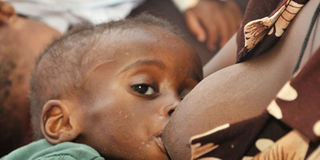High malnutrition worries authorities

According to the 2016 Demographic and Health Survey, malnutrition is higher among children in rural areas accounting for about 30 per cent than urban areas standing at 24 per cent. FILE PHOTO
What you need to know:
- According to the 2016 Demographic and Health Survey, malnutrition is higher among children in rural areas accounting for about 30 per cent than urban areas standing at 24 per cent.
Kakumiro District deputy chief administrative officer Joram Ssekitoleko Ssali urged all stakeholders to fight malnutrition.
Kakumiro. Irene Mukyeshiwabo, a mother of five from Kalangara Village in Nkooko Sub-county, Kakumiro District, is living in distress over the health of her children.
Mukyeshiwabo, is always moving back and forth from one health centre to another in search of treatment for her children. She is worried that her children may never grow like the rest.
‘‘My children are always sick, they are very weak and I fear they may end up dying. Health workers tell me that I should feed them properly but where can I get the good food to give them?,” she asks.
‘‘The only food we have is maize, which I just prepare and give the children without sauce because we don’t have beans,’’ she adds.
Ms Evelyn Kusiima, the Bunyoro Sub-region’s program manager for World Vision, says at least 33 per cent of children below five years in the area suffer from severe malnutrition.
However, she says it is attributed to other factors other than shortage of food. She expresses concern that despite sufficient food in homes, many children are still malnourished.
‘‘I have visited many families in this area and found out that people have food but I wonder why 33 children in every 100 are severely malnourished. We need to wake up and help our people to fight this,’’ Mr Kusiima says.
She thinks women are not breast feeding their babies long enough.
“Women should breast feed their children right away from birth up to six months before introducing other foods,” she adds.
As a result, World Vision has intervened to mitigate severe children malnutrition by feeding the affected children on mixed dietary meals called PD-HEARPH (Positive Deviance Hearph) locally known as ekitoobelo.
She says under this programme, rehabilitating a child who has severe malnutrition is done using tools which include testing the child.
A severely malnourished child presents signs such as oedema, which is swelling of the child’s body caused by weight loss, and stunted growth or obesity.
‘‘Malnutrition can either be under-feeding or over-feeding. We tackle severe cases with a type of food which is called PD-HEARPH. We mix food of all nutrients, vitamins, salts, proteins, carbohydrates and fats in one meal to the child who is sick and his or her immunity is improved,’’ says Sensiyo Yikiriza, nutrition coordinator at World Vision in Kibaale.
He adds that they monitor the growth of the child for about three month by doing tests on weight after which they continue feeding the child.
According to the 2016 Demographic and Health Survey, malnutrition is higher among children in rural areas accounting for about 30 per cent than urban areas standing at 24 per cent.
Kakumiro District deputy chief administrative officer Joram Ssekitoleko Ssali urged all stakeholders to fight malnutrition.




